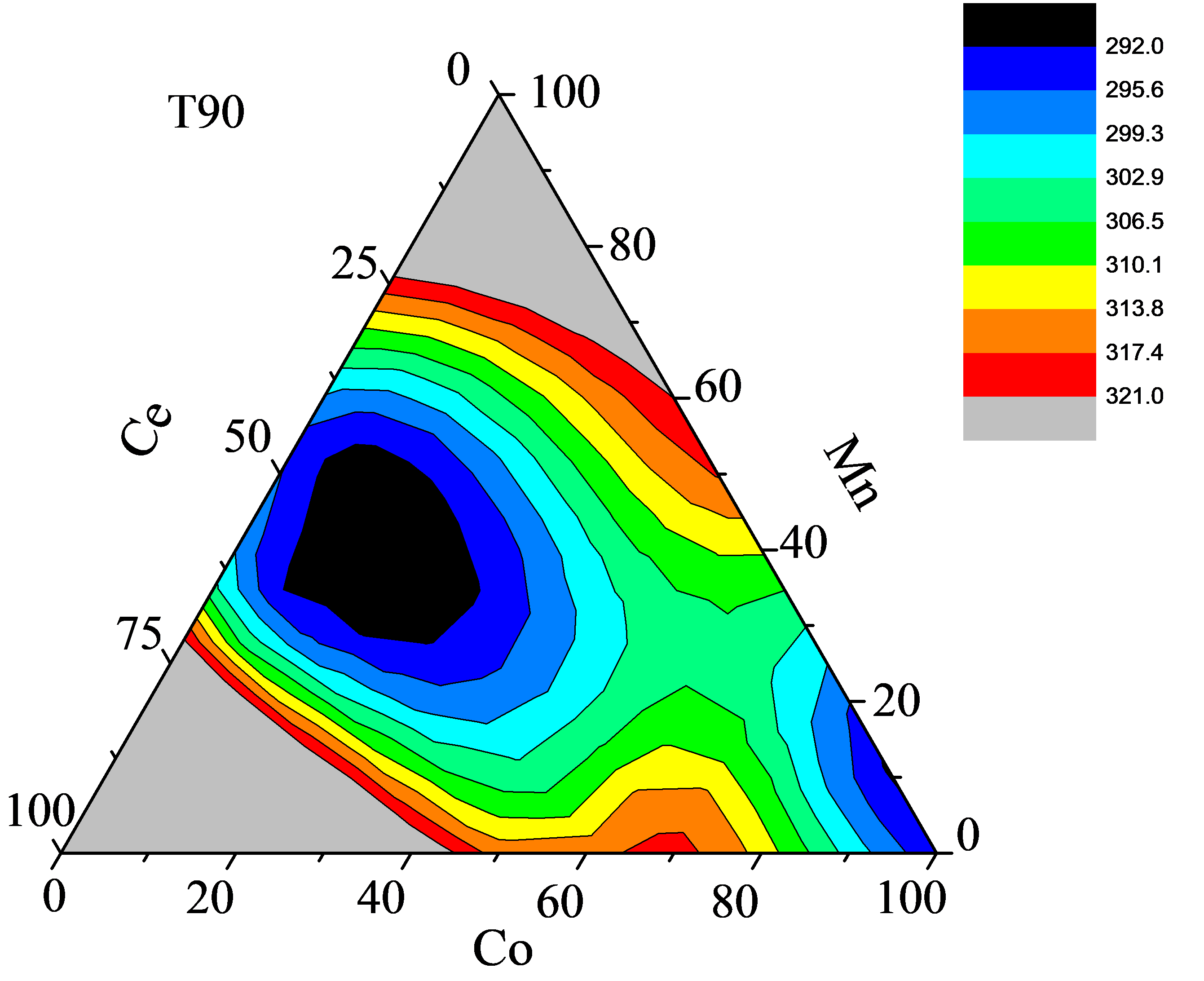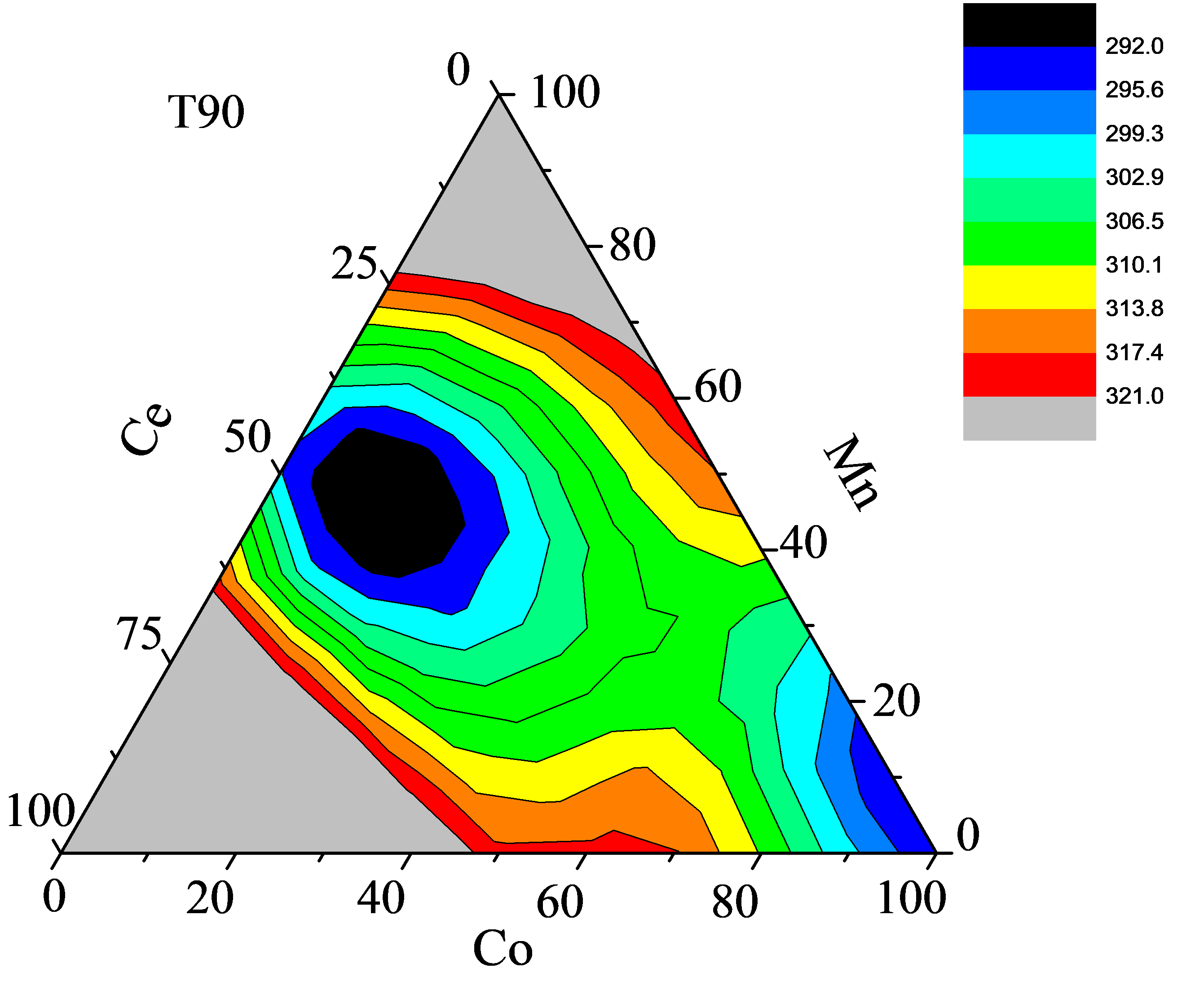金属氧化物催化剂的制备及其催化甲苯性能研究毕业论文
2020-04-20 13:47:09
摘 要
挥发性有机物(VOCs),包括芳香烃、醇、酮、卤代烃等,这些物质被广泛应用于喷涂,印染,制药等行业,是人类生活息息相关不可或缺的组成部分,但是由于其对生态环境和人体健康有着巨大的危害,目前VOCs处理问题已引起了社会的广泛关注。
处理VOCs的方法主要是(1)冷凝回收法、(2)吸附法、(3)燃烧法等。其中燃烧法可分为直接燃烧法和催化燃烧法,催化燃烧法由于能耗低、转化率高等优点,得到广泛使用。但是贵金属价格高昂,所以开发出一种具有高转化活性的非贵金属催化剂是非常有意义的,并且我国稀土资源比较丰富,并且CeO2具有良好的储氧性能,所以在本文主要介绍了钴锰铈(Co-Mn-Ce)催化剂对VOCs进行催化。沉淀法、混合法法是常用的制备催化剂的方法。通过改变pH值、元素含量、水热温度、前驱体种类等条件对催化剂进行优化。通过改变制备条件对催化剂活性进行改善,如各氧化物含量、pH、水热温度和焙烧温度等。研究结果如下:(1)通过改变催化剂中钴锰铈各元素的含量,得到最优元素质量百分数的钴锰铈催化剂,即12Co47Mn41Ce;(2)经过钴锰铈催化剂的制备条件的调变,对钴锰铈催化剂的制备过程的参数进行优化,制备过程的最优条件是:pH为9,水热温度为25°C;(3)在对催化剂的pH和水热温度的研究过程中,发现催化剂的粒径、比表面积、T90之间呈现较好的对应性。
关键词:催化燃烧 甲苯 Co-Mn-Ce
Preparation of metal oxide catalyst and its catalytic properties of toluene
Abstract
VOCs (volatile organic compounds), including aromatic hydrocarbons, alcohols, ketones, halogenated hydrocarbon, etc., is an indispensable part of human life is closely linked, but due to its has tremendous harm to the ecological environment and human health, the VOCs treatment problem has caused the wide attention of the society.
The main methods to deal with VOCs are (1) condensation recovery method, (2) adsorption method and (3) combustion method.
The catalytic combustion method often USES precious metal catalyst, non-precious metal catalyst and so on.
But the high price of precious metals, so developed a non-noble metal catalysts with high conversion activity is very meaningful, and abundant rare earth resources in our country, and CeO2 good oxygen storage performance, so in this article mainly cobalt catalyst cobalt and manganese cerium (Co - Mn - Ce) catalyst for catalytic VOCSs.
The catalyst was optimized by changing pH value, element content, hydrothermal temperature and precursor type.
The catalyst activity was improved by changing the preparation conditions, such as oxide content, pH, hydrothermal temperature and roasting temperature.
The results are as follows :(1) by changing the content of various elements of cobalt-mn-cerium in the catalyst, the cobalt-mn-cerium catalyst with the optimal element mass percentage was obtained, namely 12Co47Mn41Ce.
2) after manganese cobalt catalyst preparation conditions of the modulation, preparation process condition is: pH 9, hot water temperature at 25 ° C;
(3) in the process of studying the pH and hydrothermal temperature of the catalyst, it was found that there was a good correspondence between the particle size, specific surface area and T90 of the catalyst.the cobalt, manganese and cerium composite metal oxide catalyst was prepared under optimal conditions.
Keywords: catalytic combustion;methylbenzene ;Co-Mn-Ce
目录
摘要 I
Abstract II
第一章 概述 1
1.1 课题研究背景 1
1.1.1 VOCs的概念与来源 1
1.1.2 VOCs的危害与影响 1
1.1.3 VOCs的处理技术 1
1.2 VOCs的催化氧化技术——以甲苯为例 2
1.2.1 甲苯的来源及危害 2
1.2.2 甲苯的催化氧化技术 2
1.2.3 提高甲苯催化氧化速率的方法 2
第二章 实验部分 3
2.1 前言 3
2.2 催化剂制备方法 3
2.3 实验试剂及实验仪器 3
2.3.1 实验试剂 3
2.3.2 实验仪器 5
2.4 催化剂表征 6
2.4.1 热重(TG) 6
2.4.2 X射线粉末衍射仪(XRD) 6
2.4.3 低温氮气吸脱附(BET) 6
2.5 催化剂活性评价体系 7
2.5.1 催化剂评价系统装置 7
2.5.2 催化剂床层恒温区校正 9
2.5.3 催化剂性能评价 10
2.6 甲苯浓度标准曲线绘制 10
2.6.1 甲苯浓度标准曲线绘制操作流程 10
2.6.2 甲苯浓度标准曲线绘制 11
第三章 沉淀法制备钴锰铈复合金属氧化物VOCs催化剂…..………………..….12
3.1前言 12
3.2元素含量对钴锰铈催化剂的影响 13
3. 2.1 钴锰铈催化剂的制备 13
3. 2.2 元素含量对催化剂活性的影响 14
3.2.3 热重分析 18
3.2.4 XRD和BET分析 19
3.3 pH对催化剂的影响 20
3.3.1 pH调变对催化剂活性的影响 20
3.3.2 XRD和BET分析 21
3.3.3 主要影响因素 23
3.4 水热温度对催化剂的影响 24
3.4.1 水热温度对催化剂活性的影响 24
3.4.2 XRD和BET分析 24
3.4.4 主要影响因素 26
3.5 焙烧温度对催化剂的影响 27
3.5.1 焙烧温度对催化剂活性的影响 27
3.5.2 XRD和BET分析 28
3.6 催化剂的稳定性 29
3.7 本章小结 30
参考文献 31
致 谢 33
第一章 概述
1.1课题研究背景
1.1.1VOCs的概念和来源
VOCs是一大类碳基化学物质,在室温下很容易挥发。VOCs被分类为造成空气污染物的主要原因是它们既间接地作为形成光化学烟雾的前体,也直接作为有毒物质作用于环境。快速的城市化和工业化导致挥发性有机化合物向环境的排放不断增加。VOCs的来源有燃料燃烧、化工、生物圈和生物量分解、制药厂、汽车工业、纺织制造、溶剂加工、清洁产品、印刷机、绝缘材料、办公用品、打印机等。最常见的VOCs是卤代化合物、醛类、醇类、酮类、芳香族化合物和醚类等。
1.1.2 VOCs的危害与影响
以上是毕业论文大纲或资料介绍,该课题完整毕业论文、开题报告、任务书、程序设计、图纸设计等资料请添加微信获取,微信号:bysjorg。
相关图片展示:







课题毕业论文、开题报告、任务书、外文翻译、程序设计、图纸设计等资料可联系客服协助查找。



